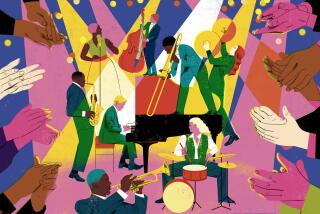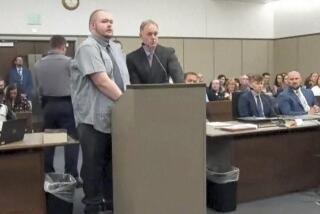21 Die in Stampede at Club in Chicago
CHICAGO — Security guards using pepper spray to break up a fight in an illegal nightclub early Monday triggered a stampede that killed 21 people and injured more than 50, police said, as hundreds of club-goers tried to flee the bar only to be trapped in a single overcrowded stairwell.
Most of the dead appeared to have been asphyxiated and some suffered heart attacks, officials said, as they were trampled in the stairway leading from the second-floor dance area of Epitome, a high-priced bar and restaurant that caters primarily to African Americans.
Witnesses said a second-floor door was locked and chained, and fire officials said other doors were illegally locked or blocked. The throng tried to flee down the stairwell that led to the front door of the dance club, named E2. The second floor -- where patrons had been dancing -- was ordered closed in the summer for repeated safety violations, including a lack of exits and exit signs.
By the time firefighters arrived, the lone exit was clogged with the injured and the dead, and bodies were piled against the double-paned glass.
“It was chaos,” one patron said a few hours after the disaster. “It was madness.”
The stampede is reminiscent of other incidents in which large numbers of people were trampled. In 1991, nine people in New York were crushed to death in a gymnasium stairwell while awaiting a celebrity basketball game. In 1979, 11 died in Cincinnati as a crowd rushed for the best seats at a concert by The Who.
“Chicago is a city in deep mourning today,” said Police Supt. Terry Hilliard. “While these deaths were sudden ... our investigation will not be over quickly. We will get to the bottom of this.”
City building codes limited the number of people in the first-floor restaurant to 327. Authorities said Monday they did not know what the legal capacity of the dance area had been, but in July a state court ordered the owners not to use the second floor for any public events. Estimates of the number of patrons in the club during the panic early Monday ranged from 500 to 1,500.
According to business records, the club is owned by Lesly Motors, which is next door, and Chicago attorney Dwain Kyles and his business partner Calvin Hollins.
Hollins, president of Epitome, served prison time in the 1980s for shooting a man outside another nightclub, according to police records.
“The owner knows damn well he’s not to open that second-floor facility,” said an angry Chicago Fire Commissioner James Joyce.
The panicked exodus began about 2:15 a.m., when security guards stepped in to break up an altercation that witnesses said involved two women.
Some witnesses said the guards sprayed a crowd-control agent into fans that were blowing in the crowded room, though police could not confirm that.
At 2:23 a.m., a 911 call reporting “a pregnant woman down” was routed to the Chicago Fire Department, Joyce said.
“The first companies on the scene saw other people down on the stairwell and ... people against the doors trying to get out,” Joyce said. The paramedics immediately called for help.
Soon, about two dozen ambulances, a dozen firetrucks and numerous other emergency vehicles arrived at the club on South Michigan Avenue, minutes from the city’s Loop business district.
One fire engine drove to the back of the building, Joyce said, where firefighters smashed the locks or chains on several doors with sledgehammers. Patrons then burst through some of the doors.
Inside one door, near the kitchen, the firefighters discovered four people in cardiac arrest who had apparently been dragged there. Joyce said it was unclear whether anyone had tried to escape through the locked or blocked doors.
Witnesses said that the crowd fled because the guards used pepper spray in the hot, crowded room.
“People were throwing up everywhere,” said one young man, who declined to give his name. “People throwing up and running and tripping everywhere. I saw people lying everywhere.”
Three people were pronounced dead at the scene in early morning, though firefighters said they had carried out several more who appeared to already have perished. By late in the day, the number of dead stood at 21.
“How many died?” 24-year-old Anthony White, who said he had visited the club before, asked one of the firefighters at the scene.
“Twenty-one so far,” the firefighter said.
“Oh, no. Oh, no.”
Ambulances sped victims to nine hospitals, where relatives collapsed with grief in the waiting rooms and sobbed as they ran through the emergency room doors.
“These bodies were smashed ... faces, torsos, legs. It’s like a steamroller rolled over them,” the Rev. Eric Sloss told the Chicago Tribune as he comforted families at the University of Illinois Medical Center at Chicago. “It’s horrific.”
The club, formerly called La Mirage, Heroes, and The Clique, has been one of most prominent, priciest restaurants and dance venues catering to blacks in Chicago for 17 years, attracting such hip-hop and pop music figures as Sean “P. Diddy” Combs, Jay-Z and R. Kelly.
Security was often tight at the club, with guards locking doors to prevent people from sneaking in to avoid cover charges as high as $100, and to help control crowds, club-goers said. Epitome and its predecessors also have been the scene of numerous crimes inside as well as outside, according to police records.
In September, a 22-year-old woman was shot to death outside the club, and in January a woman died in a car accident after leaving Epitome, where she allegedly had gotten drunk.
Since 2000, police have responded to calls at the club 80 times, mostly for fights, Hilliard said.
The high-priced menu and live jazz in the restaurant area tended to lure well-dressed couples and sometimes families, while the dance club drew both rich and poor as well as number of troublemakers, some from nearby housing projects, according to owners and police.
In 2002, part-owner Kyles wrote Alderman Madeline Haithcock asking for her help in getting more police to patrol the area. Haithcock wrote back encouraging him to work with police but also said: “I will not be available for any support in the future.”
An April 2002 article in the Chicago Defender newspaper said Kyles was planning to change the type of music at the dance club from heavy hip-hop to mellower music -- hoping to lure a quieter clientele -- because police and city officials were threatening to close it because of violence.
“The music has a lot to do with who you attract in this business,” Kyles told the Defender.
On Monday, several club-goers said they hadn’t noticed a change in musical styles.
As police interviewed dozens of people and viewed videotape from the club in trying to determine what the fight was about and how security guards reacted, fire and building investigators searched for safety violations. They found many, officials said.
Joyce, the fire commissioner, said the restaurant section of the club has “some history of violations [but] it doesn’t appear to be an overwhelming number of violations.”
When inspectors last visited the restaurant, in the fall, they found no problems. They did not inspect the upper level, Joyce said, because it was not supposed to be in operation.
On Monday, however, they discovered exit doors throughout the building that were locked, doors that were chained, doors blocked by boxes and others by bags of laundry.
Shivering in the cold, White stared at the club from behind police tape as sirens wailed and firefighters rolled up a hose.
“I guess I better go check the hospitals, the morgue,” he said. “I bet I know somebody there.”
More to Read
Sign up for Essential California
The most important California stories and recommendations in your inbox every morning.
You may occasionally receive promotional content from the Los Angeles Times.










